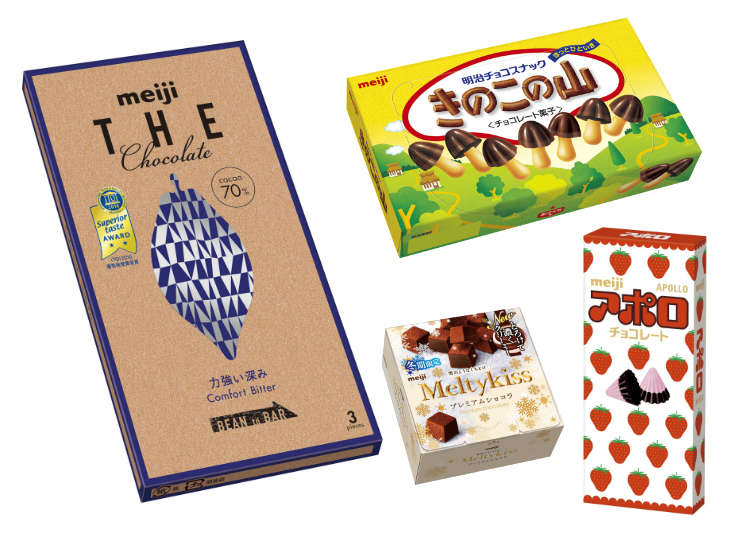
Every person can name a handful of their favorite sweets and treats from their childhood – this is no different for people who grew up in Japan. On top of such a list, certain evergreens from Meiji, one of Japan’s biggest and most famous sweets makers, are sure to be found: Kinoko no Yama Mushrooms, Takenoko no Sato Bamboo Shoots, and Apollo are only some of them.
While Japanese often associate Meiji with the tastes of their childhood, the company has released a chocolate in September 2016, targeted at these now all-grown up generations, simply called The Chocolate. What one might have brushed off as a chocolatey one-hit wonder at first, has conquered the nation by storm, deserving of a closer look.
Prior to its official launch, The Chocolate had already received multiple international chocolate awards, and with an entirely new packaging, it attracts quite a lot of attention. The Chocolate has a story unlike any other cacao delicacy. Why did a company with an image that is so closely connected with childhood sweets and treats suddenly decide to take an entirely different approach? We decided to ask Meiji directly.

Those who regularly shop at supermarkets and convenience stores are likely to remember spotting The Chocolate in between the other products. Its packaging with a modern, stylish design particularly stays in one’s mind and isn’t only talked about on the Internet but can even be seen decorating someone’s smartphone from time to time. Three small bars can be found in one such package and hold a taste that has been acclaimed by Europe’s top chefs and sommeliers, receiving the iTQi (International Taste & Quality Institute) Superior Taste Award in 2016, as well as a bronze medal in the Americas and Asia Pacific Competition 2016 of the International Chocolate Awards.
A lot of Japan’s chocolate specialty shops have started to enter their creations in international competitions and do so with great success, but seeing entries from a big manufacturer is far rarer.
“We are really happy with the outcome, competing against famous chocolatiers from all around the world and eventually winning with our own high-quality creation. I am particularly proud because due to our commitment, I never thought that we could not beat the specialty chocolatiers,” says Masahiro Sato from Meiji’s Sweets Marketing Department, remembering his thoughts and impressions of that time vividly. Together with Maiko Yamashita and Hiroyuki Ustunomiya of the Confectionary Goods Development Department, three people granted me an interview, all three of them marked as “In Charge of Specialty Chocolate.” From the confident expressions on their faces, it was immediately clear that the strength of this team must have been a big influence in winning the aforementioned awards.
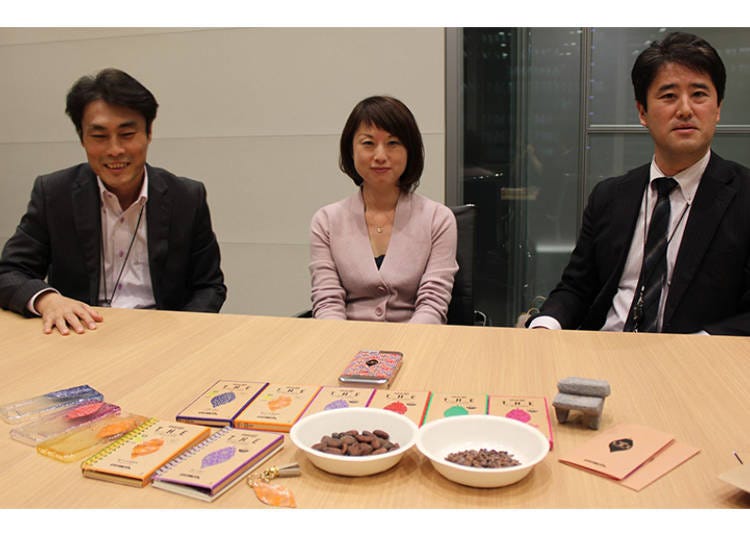
Meiji’s High-Grade Chocolate – A Trial-and-Error Journey of 30 Years
The know-how of 90 years of making and selling the famous Meiji Milk Chocolate is also the story of the technologies and challenges of “bean to bar.”
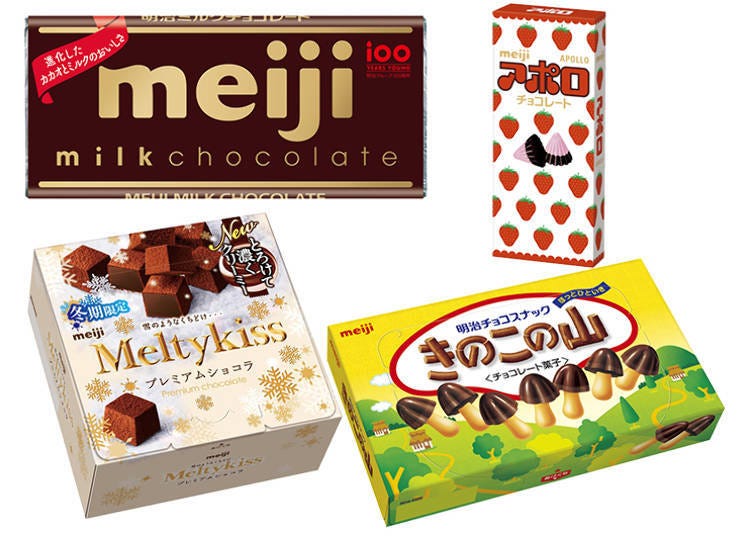
Sato-san: “Actually, the classic Meiji Milk Chocolate is consistently made within the company, from the beans to the finished chocolate bar. Using all of those techniques, we changed the cacao brand we used five different times as we tried to create a high-grade chocolate product, starting with Corazon Cocoa in 1986. But it was hard to get support.”
Yamashita-san: “I think one reason for that was the influence of Meiji’s shipping development. In the 1970s, Apollo and Kinoko no Yama Mushrooms started being sold and Meiji chocolate was established as a treat for children. This image started to change in the 1980s with Meiji’s Meltykiss and products of other companies, increasing the age range of chocolate. But putting these products in stores and suddenly saying ‘This high-quality cacao chocolate,’ customers wouldn’t have had the sensibility for that. The current The Chocolate is actually the successor of a same-named product that was released in 2014 was also still a bit too early.”
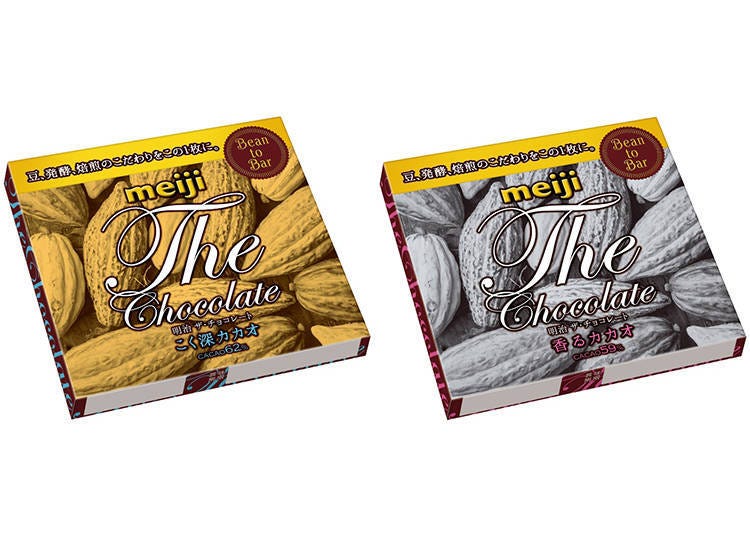
The fact that the increase in numbers of internationally owned chocolates and specialty shops in Japan is said to capture the changes of the market rather than jumping on the high-grade chocolate bandwagon. But instead of joining this high-grade chocolate boom, Meiji’s The Chocolate used this time to be perfected by trial and error. Finally completed and being introduced to the global world of chocolate, it seems that both a mature market and the high quality of the product are the main reasons for the massive success of The Chocolate.
Competing Globally with Quality
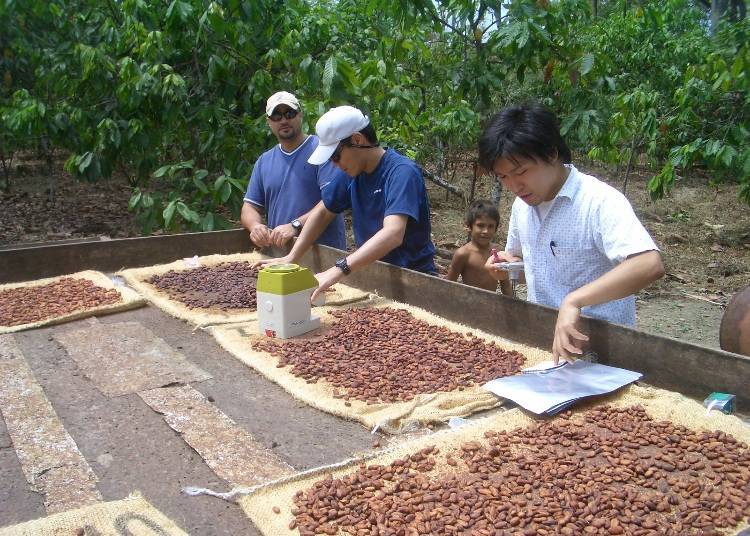
In recent years, the global trend has tipped towards purchasing the raw cacao beans after they’ve been processed, but in the case of Meiji’s The Chocolate, Utsunomiya-san personally visits the cacao plantations in South America to check on the plants, people, and equipment. The farmers are supported, the beans are grown with specific methods, and the final products are mutually taste-tested and discussed – very close communication is the key to this strategy.
During development, the method of choosing what would become The Chocolate was surprisingly classic, seemingly going against the trend of the time. The reason for this is the special missions that this chocolate represents: one is the strong desire to “change Japan’s food culture,” while the motto of “manufactured in Japan, a different kind of quality” seeks to confidently and determinedly have Japanese products compete on a global level.
Utsunomiya-san: “In quantitative business, the products are no match for the globally developed ones, and right now, they cannot compete on a global scale. So our thought is to firstly try to compete with quality. Actually, the quality of chocolate is generally dependent on the cacao beans. This is why we try very hard to grow high-quality beans, choosing the best beans carefully at excellent plantations. This is the concept we make our chocolate with, and with The Chocolate, made with this concept in mind, we seek to change the Japanese chocolate market. We make our chocolate with Japanese quality standards and a global way of thinking.”
Apparently, this global way of thinking also influenced the way The Chocolate tastes, while also incorporating the preferred tastes of Japanese people.
Utsunomiya-san: “This time, we were consciously thinking about a global taste. Thus, we haven’t used certain flavors that we have used before. Since we’re selecting the cacao beans so carefully, we should be confident in our product, right? So we raised the cacao percentage of the chocolate just a bit more. Instead of accommodating to the Japanese preference for milk chocolate, we went into a slightly more bitter direction. All six The Chocolate variations have little sugar in them, and to cater to the milk chocolate fans, we created “dark milk” as a new category. With this, we want to take a place in the chocolate market with flavors that are different from the classic milk chocolate.”
As a result, The Chocolate’s taste doesn’t only appeal to the original European chocolate patissier but also to the Japanese consumers. Among its six types, two of them exceed 70% cacao. Usually, chocolate with a high cacao percentage tends to leave a flour-like taste in one’s mouth, but not so with The Chocolate. A judge from the iTQi noted: “As it is not too sweet, the taste is very pleasant. The flavor has not been impaired by sugar.” The Chocolate is so easy to eat, it’s barely noticeable that Meiji held back on sugar when you try it for yourself.
“Why is The Chocolate Sold for so Little Money?”
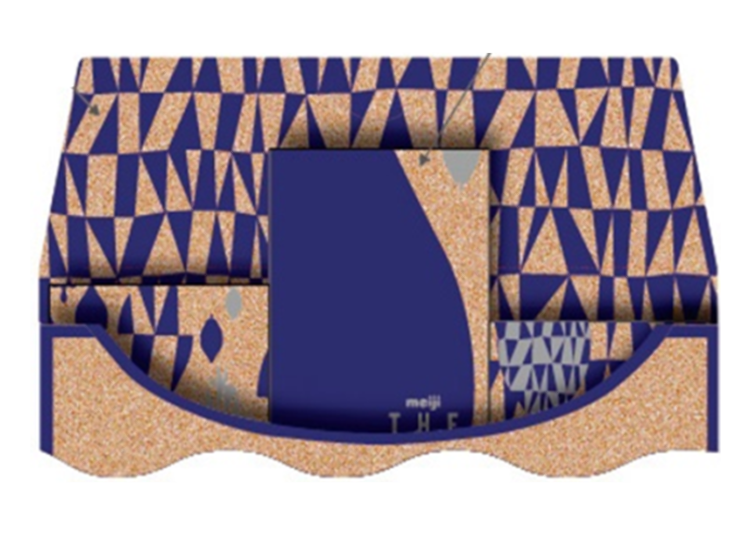
One thing that is curious about The Chocolate is that it is being sold for a price that is less than one grain of high-grade chocolate while still vouching for high quality – what is the intention behind this?
Utsunomiya-san: “We used department stores selling rather expensive, high-quality chocolate as our testing grounds to still make the chocolate affordable. Selling a product designed for convenience stores at high-class specialty shops, we came to be in the middle of the price range. While it might be expensive for a convenience store, the price is adjusted to reflect a product that you’d like to enjoy on special occasions.
Meiji is doing well in the lower market, selling products for 100 yen per piece. By raising the value of the product itself, we can make a chocolate that is both high in quality and still keep the price relatively low by mass production. In a nutshell, it is possible to offer a quality product that every person in Japan can afford. We decided to place The Chocolate in a medium price range. People can find it at their nearby supermarkets and convenience stores and enjoy the world of high quality chocolate and cacao for affordable prices. This price design, this is one thing that Meiji can do, we believe.”
In other words, the current price is exceptional. In an interview at Salon du Chocolat (a yearly chocolate festival held in Paris), Meiji was asked the same thing: “Why is The Chocolate sold for so little money?”
Utsunomiya-san: “Doubling the price would be more than fair to reflect both contents and efforts put into the chocolate. But at the same time, our product wouldn’t be as accessible. We want people to appreciate good chocolate like they appreciate good coffee, and we’re trying our best to create an era of such appreciation.”
The Chocolate Market – Continuing to Grow
For sweets makers, chocolate often is one of the main flagship products. Even Meiji has its own variety of classic and popular products, and even though attempts to create a chocolate from high-quality cacao have been going on for the past 30 years, the enthusiasm for The Chocolate is nothing but authentic. What kind of thoughts and research lead to its birth?
Sato-san: “According to our surveys, the chocolate market has grown steadily over the past ten years. The sweets market in total is said to be around 3 trillion yen and chocolate actually became the number one product within the sweets industry, exceeding 530 billion yen in 2016, compared to the 400 billion yen from ten years ago. One of the reasons for this is that the media has started to focus on the health benefits of chocolate, as opposed to its old negative image of getting bad teeth and weight. As such, the demand for chocolate among all age groups has increased, particularly among the elderly population.”

Sato-san: “The average chocolate consumption of a Japanese person is around 2 kilogram. In terms of Meiji Milk Chocolate, that is about 40 bars. One of the world’s top chocolate-eating nations is actually Germany, consuming six times more chocolate than Japan. You might think that it is a matter of climate, but even countries with a similar climate to Japan, such as Spain, Portugal, and Italy, consume 1.5 times more chocolate. Looking at the growth of the last 10 years, though, the market is sure to grow even more.”
Yamashita-san: “In Europe, men and adults in general also do not think twice about eating chocolate, as opposed to Japan. This is evident in the rate of consumption. Wondering why this is not the case in Japan, we wanted to make a specialty chocolate that Japanese adults would want to eat, and also to make chocolate a part of Japanese food culture.”
Chocolate, Enjoyed Like Wine and Coffee
Even when looked at the topic from the angle of consumption, it is clear that there are still many secrets left to discover when it comes to chocolate.

Yamashita-san: “With specialty companies and stores like Blue Bottle Coffee and Third Wave, coffee has undergone an immense evolution as a luxury product. And while wine doesn’t have a very long history in Japan, it is now firmly rooted as a luxury product ever since the health boom. Chocolate also has a different taste depending on where it is produced, how it was produced, and what kind of ingredients are being used, just as complex as wine. If people were aware of this, I do believe that chocolate would quickly join the ranks of luxury goods. Cacao does have all kinds of different flavors but past Japanese chocolates have only offered choices between sweet and bitter. To show people the differences and nuances, we started to make chocolate with four kinds of flavors.”
What’s Inside? – A Whimsical Box Design that was frowned upon within the Company
One thing that cannot be dismissed when talking about The Chocolate is the design of the box. As for chocolate, it can be said that it is a particularly appealing one to female customers. One might already have a strong opinion about that, but the design can also be called very minimalistic.
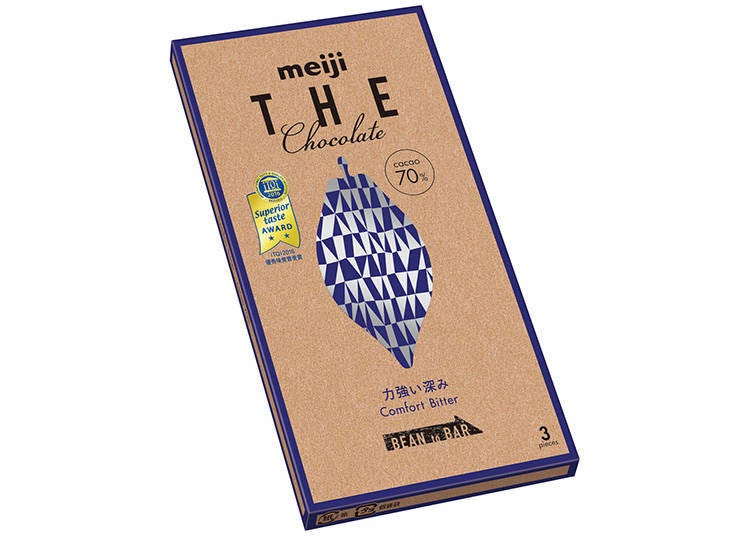
Yamashita-san: Utsunomiya-san and his team have made it their mission for the last 10 years to create high quality chocolate, starting from the cacao beans and their place of origin. This is the foundation of The Chocolate. In order to offer it to Japanese consumers as a luxury product, however, we needed to change a few sentiments first. We needed a design that doesn’t make The Chocolate look like just another sweet snack but conveys the image of a luxury product to the whole world with a single glance. It needed to be different from everything else.”
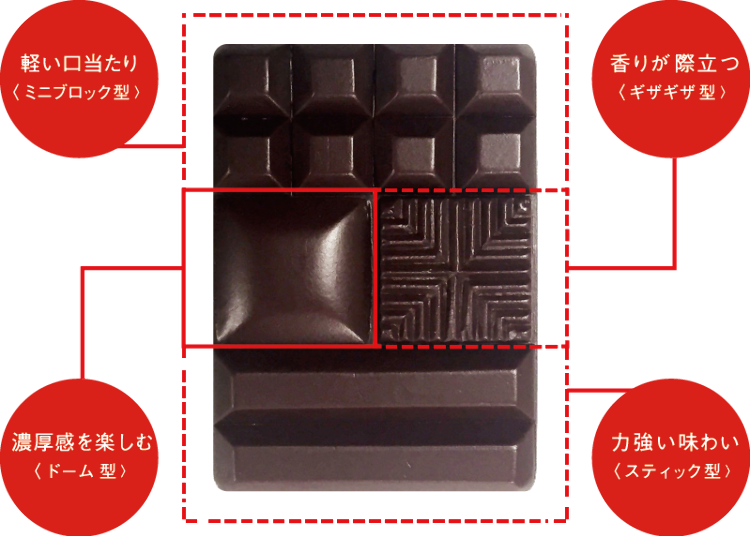
When you open up a box of The Chocolate, you’ll find a bar that is divided into various shapes. According to the official website of Meiji, the taste of the chocolate is different depending on the shape, something that can only be fully understood when tried. What is the idea behind these different shapes in one box?
Yamashita-san: “This time, this also was a point, yes. Usually, you can immediately tell what kind of chocolate awaits inside, its color, its shape, just by looking at the package. Designed with a photograph, and the classic colors of chocolate, such as gold and red, we tried to tell everything about the product on the package. This time, however, we decided not to choose a too overwhelming design. We even adapted the shelves and the price tags, to create an image like a chocolate specialty store. Quite a lot of thought was put into it.”
Sato-san: “When Yamashita-san proposed this design, I said: ‘Will that be alright? I don’t understand what the contents of this package are!’ There were a lot of opinions within the company but we thought to ask our customers first. And they gave this design a very high rating, which did surprise us! (laughs) Even then, our in-house sales team kept saying ‘This is impossible.’ Even we were surprised that an unconventional product like The Chocolate ended up being sold, in the end. To the people who said that it’s impossible, we replied: “We thought so too, but you’re not the target for this product. Let’s not look at this with our own subjectivity, shall we.” And they said: “Yeah, you might be right!” (laughs)
The previous “The Chocolate” had seven individual package designs but the 3-bar division of the current The Chocolate suggests that Meiji wants to establish a new standard when it comes to chocolate bars. It’s both symbolic of a classic chocolate bar and can be eaten in one sitting. The size is large enough to make you remember the taste but small enough not to cause any bothersome leftovers.
Breakthrough Sales: Over 10 Million Chocolates Sold Breaks Meiji’s Records
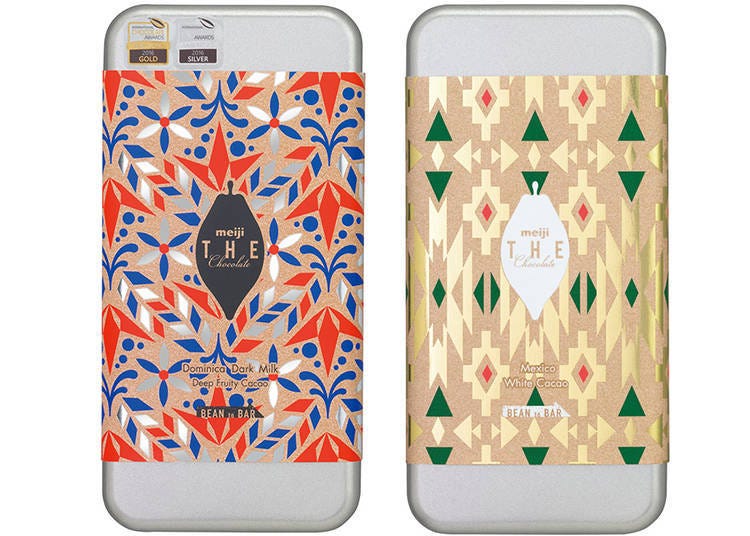
Originally, Sato-san was skeptical about the sales target for The Chocolate, wondering: “Can we really achieve this?” However, it seems that it was an inevitable choice to start with high goals as The Chocolate itself carries an important mission for the entire company of Meiji. The product’s launch was a massive success. The sales of the current term were twice as high as the original target and as of January 2017, over 10 million units of The Chocolate have been sold. With this, The Chocolate has already met its sales goal for the year at a very early date. Sato-san says that it is not a product that stands out at special sales counters but rather does well at the standard chocolate aisles, thus being a record-breaker for Meiji.
For Valentine’s Day, Meiji launched two limited flavors for The Chocolate that were sold at Salon du Chocolat 2017, which was held at the Tokyo International Forum in early February. One of them, the Dominica Dark Milk won Gold and Silver Awards at the International Chocolate Awards Americas and Asia-Pacific competition. The other special edition was called Mexican White Cacao and a dark chocolate made with white cacao, a type of cacao that is said to be rather rare and is known for its subtle bitterness and gentle astringency. Both were sold in their own unique beautiful boxes.
Valentine’s Day shopping season marked “the year’s biggest opportunity to connect with the customers. Of course, we are also hoping for a business success, but first and foremost we want to change the chocolate culture in Japan.” In the box, a little booklet is included, informing the buyer of how to enjoy cacao and chocolate, featuring charts that evaluate the different varieties in regards to their aroma, sourness, sweetness, and more. “We want you to enjoy the differences in taste and fragrance.”
With Valentine’s Day having brought forth two intriguing The Chocolate varieties, we can look forward to upcoming seasonal tastes and surprises.
From the development to the final release, The Chocolate transmits the passionate belief of fundamentally changing the chocolate culture in Japan. While the three main people carrying The Chocolate project with a lot of enthusiasm laughingly agree that “you can’t just mix together cacao, milk, and sugar,” they already think about what path The Chocolate will continue hereon. Certainly, The Chocolate and its mission have just started to take root, and there are more challenges to come – we are looking forward to how this “bean to bar” treat will continue to develop and surely keep to surprise us.
Rai Asaka
The vivid sound when breaking the chocolate seems to be a proof that both the ingredients harmonize excellently and the methods of making the chocolate are equally great. The Chocolate fascinates me, and I do break various chocolates.
- Category
*Prices and options mentioned are subject to change.
*Unless stated otherwise, all prices include tax.
Popular Tours & Activitiess
Recommended places for you
-
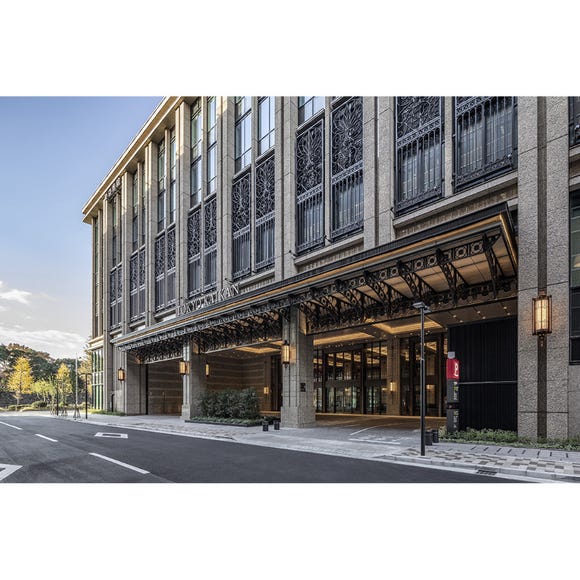
TOKYO KAIKAN
Other Restaurants
Ginza
-

fes Fuesu
Other Restaurants
Umeda, Osaka Station, Kitashinchi
-

BUDDY BUDDY
Other Restaurants
Sapporo / Chitose
-

Birthday Surprise x KUJIRA ENTERTAINMENT DINING
Other Restaurants
Shinjuku
-

PASELANamba
Other Restaurants
Namba, Dotonbori, Shinsaibashi
-

Man in the MoonKarasuma
Other Restaurants
Gion, Kawaramachi, Kiyomizu-dera Temple
-

Japan’s Shinkansen Is About to Change Travel in an Unexpected Way
by: Guest Contributor
-

Jujutsu Kaisen Takes Over JR East With a Wrapped Shinkansen This Winter
by: Guest Contributor
-
Ad

Discover the "Miraculous Forest" in the Heart of Tokyo: The Institute for Nature Study (9 Minutes from JR Meguro Station)
-

Strawberries, Style, and Tokyo’s Coolest Neighborhood: Winter Afternoon Tea in Kichijoji
by: Guest Contributor
-

This Winter, Godzilla Takes Over Haneda Airport
by: Guest Contributor
-

How to Get Don Quijote's Exclusive 2025-2026 Winter Gift (+Tax-Free Savings)
-

Rest Your Feet: 4 Perfect Organic Cafes in Shinjuku, Tokyo!
-
Ad

A Toast to Grande Polaire! Discover Japanese Wine With the Best of the Best
-

Loved by Young and Old: The Culinary Roots of Japan's Favorite Sauces and Seasonings
-

Universal Studios Japan: Guide to Osaka's Giant Theme Park Attractions!
by: WESTPLAN
-

Ueno Station Area Guide: Fun Ways to Explore Tokyo's Popular Destination (Area Map & Sightseeing Tips)
-

Crazy Japanese Drinks: These Expats Went Wild on Chuhai, Would You Try These?!
- #best sushi japan
- #what to do in odaiba
- #what to bring to japan
- #new years in tokyo
- #best ramen japan
- #what to buy in ameyoko
- #japanese nail trends
- #things to do japan
- #onsen tattoo friendly tokyo
- #daiso
- #best coffee japan
- #best japanese soft drinks
- #best yakiniku japan
- #japanese fashion culture
- #japanese convenience store snacks












